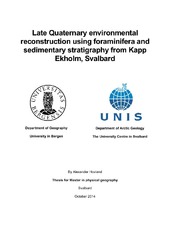Late Quaternary environmental reconstruction using foraminifera and sedimentary stratigraphy from Kapp Ekholm, Svalbard
Master thesis
Permanent lenke
https://hdl.handle.net/1956/8789Utgivelsesdato
2014-10-19Metadata
Vis full innførselSamlinger
- Department of Geography [634]
Sammendrag
SUMMARY The Kapp Ekholm sedimentary sections is a key location for our present understanding of the two last glacial cycles on western Svalbard. Its long sedimentary history (MIS 6 to present) and its position almost at the center of the Spitsbergen island distinguishes the site from other localities on Svalbard. At least four regional glacial advances are recorded in the sections and are separated by marine intervals deposited during relatively high sea level. The marine intervals show a regressive trend shallowing up-section. This stratigraphical trend is in places interrupted by deposits from slope-processes and fluvial-influence. The foraminiferal stratigraphy of the sublittoral intervals of Formation B (Eemian interglacial), Formation F (Kapp Ekholm interstadial) and Formation H (Holocene interglacial) is described and interpreted from Section II. The fauna generally shows a moderate to distal glacial influence as indicated by high ratios and frequencies of C. reniforme and E. excavatum. There no consistent up-section trend for any of the formations in terms of glacial influence. The fauna from the lower half of Formation B is interpreted to indicate inflow of Atlantic Water. The main indication of Atlantic Water masses are high frequencies of N. auricula and N. labradorica that suggest a seasonal inflow. It is suggested that this period is associated with increased Atlantic Meridional Overturning Circulation (AMOC) at the transition between MIS 6/5e or at the beginning of MIS 5e. In the upper half, the inflow is shut down, and I. norcrossi replaces both N. labradorica and I. norcrossi. This suggests a stratified hydrological environment where cold and saline water dominate like today. The foraminiferal fauna of Formation F (MIS 5a/b) and Formation H (c. 10-8 cal ka BP) shows no indiciation of warm-water inflow and local water masses probably dominated. Formations F and H differ from Formation B by having more species that are generally associated with fluvial influenced environments including A. gallowayi, E. subarcticum, H. orbiculare and. This may suggest a depositional environment closer to the coast than what is the case for Formation B.
